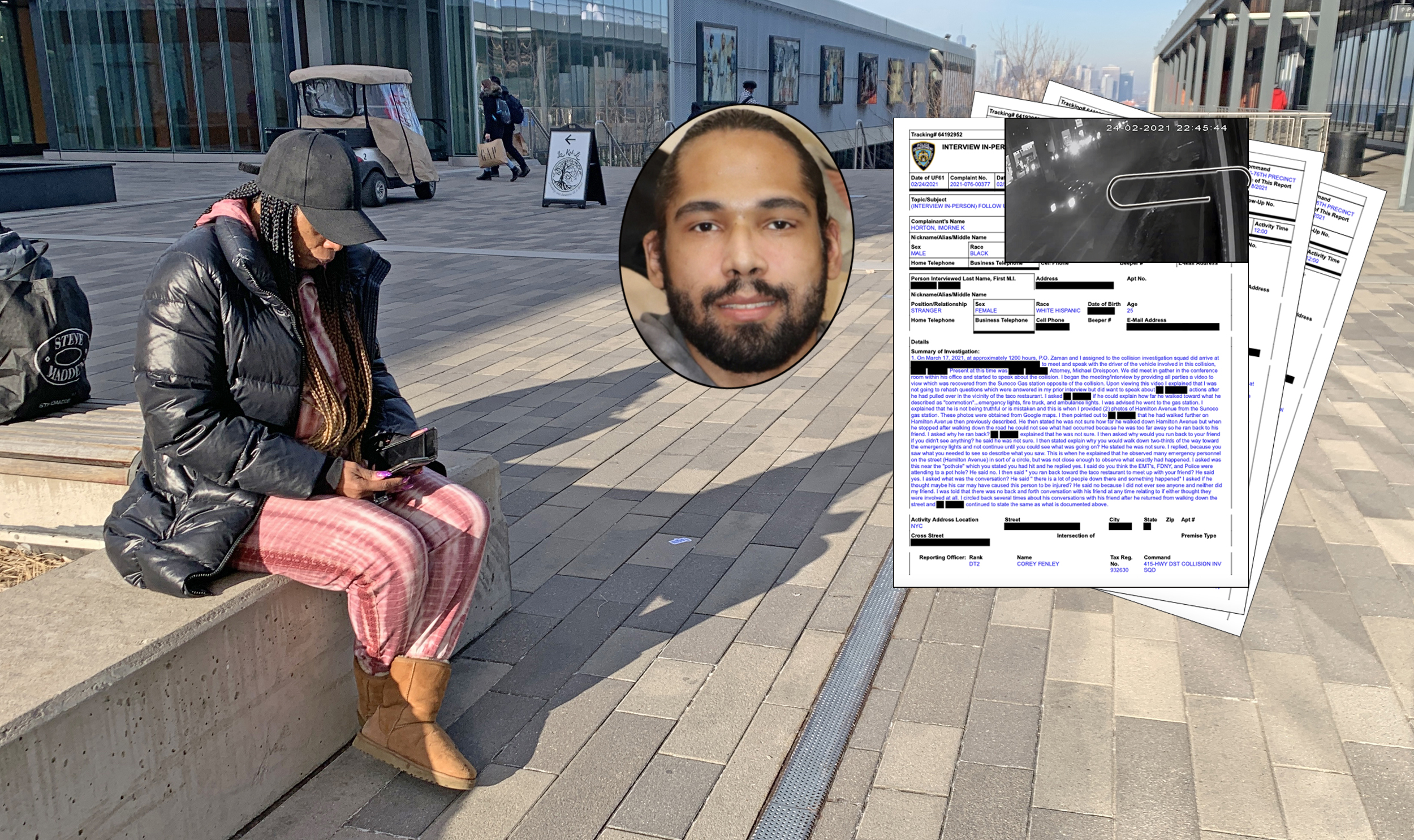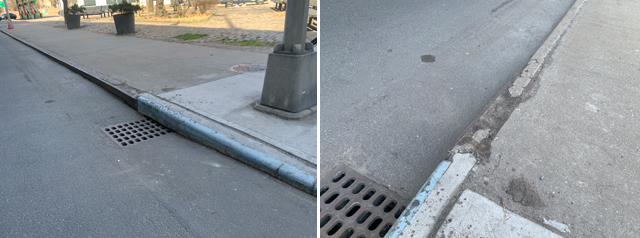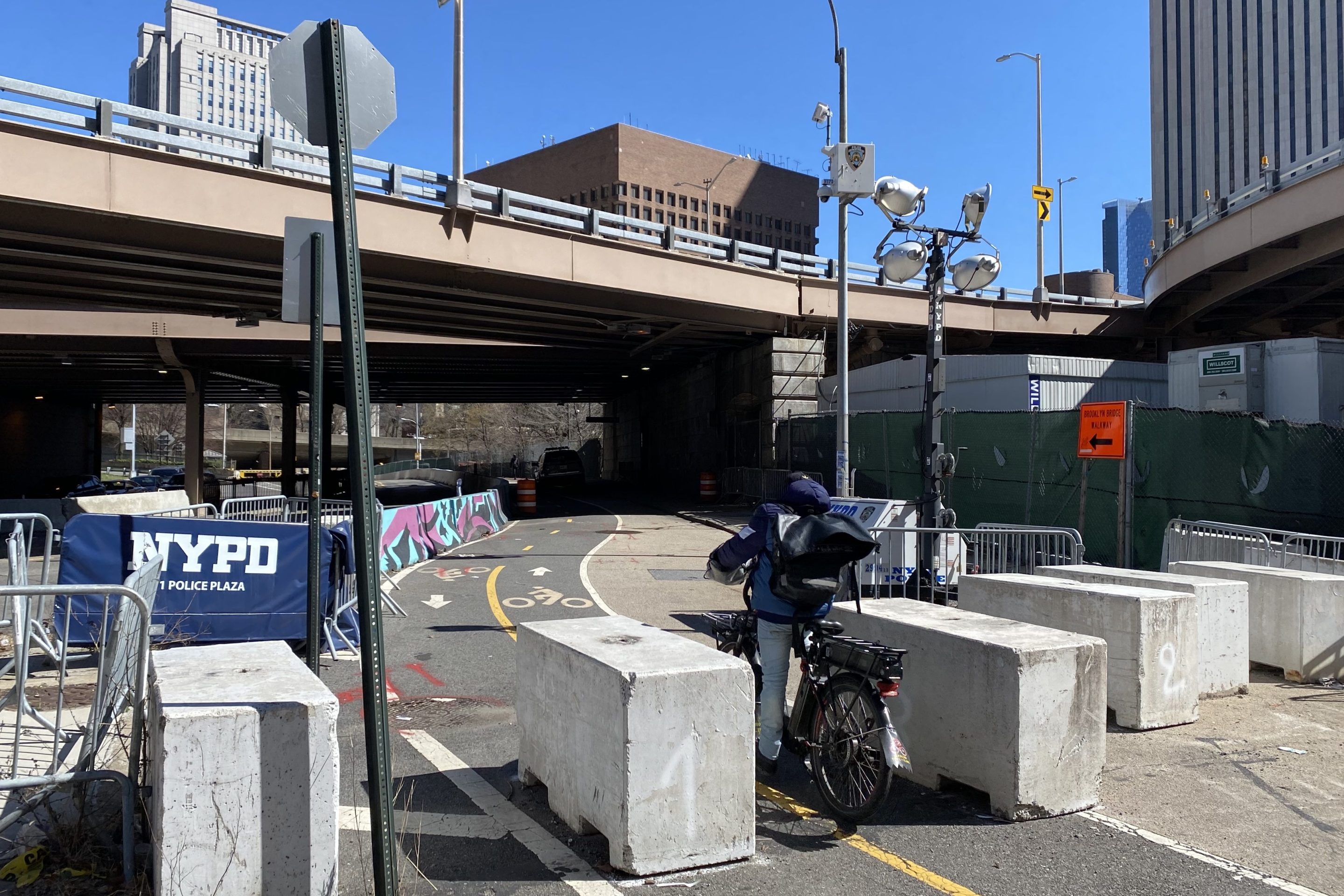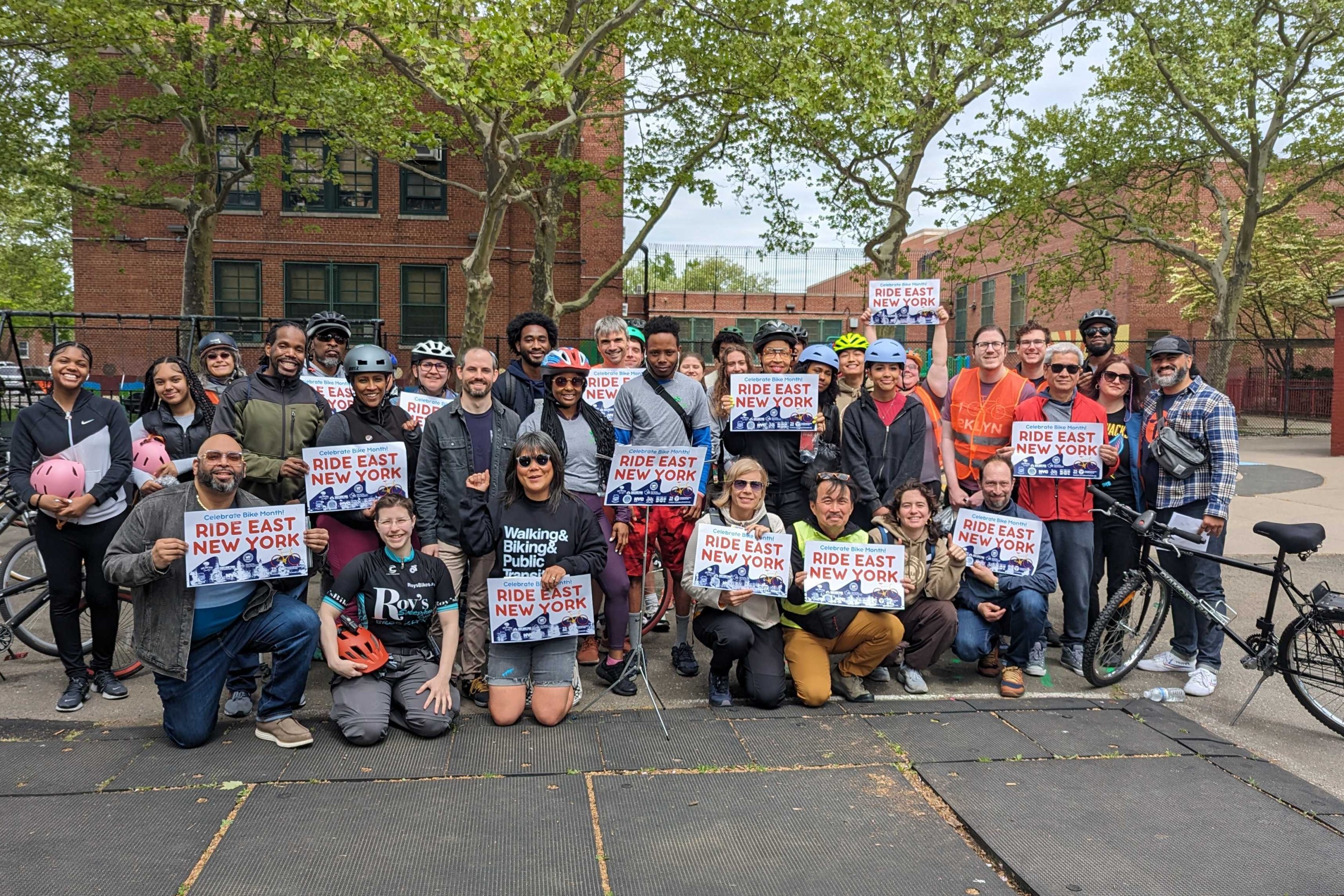EXCLUSIVE: Cops Questioned Driver in Fatal Brooklyn Hit-and-Run But Just Let Him Go
10:39 AM EDT on April 18, 2022

Grieving mother Tasha Horton still doesn’t have the answers.
He ran ... and then he walked.
The driver who struck and killed Imorne Horton on a notoriously dangerous Brooklyn roadway last year almost certainly knew he had hit something judging from his actions before and after the crash, including a flurry of calls and running away from emergency responders — yet cops declined to charge him for the killing or for fleeing the scene, according to an exhaustive review of the NYPD's case file, which Streetsblog obtained only after a Freedom of Information request and a successful appeal after the original FOIL was denied by the police department.
The Streetsblog review raises questions about police procedures and whether the NYPD and the Brooklyn District Attorney are sufficiently concerned about holding killer drivers accountable.
The full Collision Investigation Squad report in the Feb. 24, 2021 death of the 31-year-old Horton at the corner of Hamilton Avenue and Court Street contains a trove of evidence that cops unearthed yet did not deploy to charge the driver — whose name was redacted from the report — for reckless driving or for fleeing. For instance:
- Surveillance video reviewed by Streetsblog shows the driver of the red Honda that struck Horton speed through a yellow traffic light, and slam on the brakes a split-second before running over Horton, who had fallen as he made his way across Hamilton. The video shows the car rising and falling as it goes over Horton.
- In other video described in the police report, the driver is seen pulling over and inspecting the front of the vehicle — evidence that he knew he'd hit something.
- Another video shows the driver walking back towards the crash site as emergency responders circled the dying Horton, and then turning heel and running back to his car.
A month after the crash, officers questioned the driver — and confronted him with the evidence that he had killed a man and fled the scene — yet declined to charge him after the driver claimed he had merely hit a manhole cover. The case was closed shortly thereafter by the NYPD without a recommendation of charges, and referred to Brooklyn District Attorney Eric Gonzalez, who has not charged the driver.
Here's a full review of the sad case of Imorne Horton.
What happened
The following is a synopsis based on police reports, surveillance video and on-the-ground reporting:
At around 6:40 p.m. on Feb. 24, 2021, Imorne Horton, 31, was walking south on Court Street towards the intersection of Hamilton Avenue, the congested, dangerous divided six-lane mini-highway that separates Carroll Gardens from Red Hook, where Horton lived. He waited at the corner until all the cars had cleared.
Then Horton stepped off the curb and fell into the roadway. None of the three-dozen videos obtained by police show exactly what caused him to fall. The roadway at that location features a sunken sewer grate as well as a broken sidewalk, but it's unclear if these played any role in Horton's fall. His mother later told police that he occasionally suffered from seizures.

He was still on the pavement exactly 21 seconds later when the driver of a red Honda Pilot, speeding through a yellow light as it turned red, ran over him, causing grave injuries. He was taken to Methodist Hospital, where he died five hours later of severe head and torso injuries.
The investigation
The NYPD Collision Investigation Squad made a considerable effort to figure out what happened, find the car (and then its driver), collect phone records, and secure necessary documents. Few members of the public ever get a glimpse into what goes into a full crash investigation, unless they are relatives of the victim or hire a lawyer to do additional digging. Streetsblog received the case file in the Horton crash after a Freedom of Information request that was initially rejected, but granted on appeal, with the NYPD indeed agreeing with Streetsblog that the documents could be made public.
The documents show a prompt and intense effort to get to the bottom of what happened during that Feb. 24 rush hour. As an ambulance sped Horton to Methodist Hospital, where he would die hours later, CIS Detectives Christophe Paul and Corey Fenley and CIS Investigator Qamar Zaman fanned out looking for video, and soon identified 15 locations around the crash site that had cameras.
Then, in short order:
- Zaman and Fenley canvassed the area "from the collision scene expanding outward in a street by street manner" in an effort "to locate and recover a possible vehicle with front end damage." That search was futile.
- CIS investigators called back all the people who had called 911 in the seconds after the crash. None had seen the crash itself, but had happened upon its aftermath, including the driver of an Amazon-branded van who stopped to protect the victim and direct traffic around him.
In the next few hours, and continuing for two weeks, Fenley and others collected scores of video clips from a dozen locations. Very quickly, investigators identified a red Honda Pilot as the car that drove over Horton. Over the next few days, Coakley and Fenley searched for it, but did not find it.
On Feb. 26, Dr. Zhanna Georgievskaya of the Office of the Chief Medical Examiner ruled that Horton died as a result of "multiple blunt force trauma." The death certificate identified the manner of death as "an accident."
Breaks in the case happened quickly: One of the recovered videos showed the driver of the red SUV making an illegal U-turn from eastbound Hamilton Avenue at Smith Street to the westbound lanes — a clue as to where the car might have come from. Sure enough, early on March 4, Fenley spotted that very same red SUV in Red Hook and looked at the undercarriage to find fabric strands from Horton's jacket. He requested that NYPD tow truck operators remove the car as evidence.
Later that very same day, he interviewed the owner of the car at the 102nd Precinct stationhouse in Queens. And a few hours after that, he interviewed the passenger in the car that night. The passenger spun quite a story, police records show: According to this passenger, his friend had borrowed the car so they could drive to IKEA in Red Hook to pick up some shelving for a third friend not in the vehicle. When they were done shopping, they loaded the items and then they looked for a place to eat. On their way to an unidentified "taco spot" on Hamilton Avenue, the passenger claimed the Honda hit a manhole cover.
Fenley was keenly curious about this detail, given that he had already seen video that showed the red Honda hit an object in the road that made the entire chassis rise — as if it ran over something large — rather than sink, as if it descended into a pothole or depressed sewer cover. Fenley asked the passenger about it, and the passenger described the manhole in great detail, but also said the roadway was dark.
Fenley questioned the passenger about how he could provide such details about the manhole cover if it was so dark, but the passenger merely repeated that this is what he saw.
After that interview, Fenley and Coakley went to the taco restaurant — believed to be El Mexicano — and reviewed its video, which ended up providing substantial evidence. This video — which begins just seconds after the crash and just a block away — shows the following:
- the passenger and driver looking at the front of the SUV, looking for damage.
- the driver looking back down Hamilton Avenue toward Court Street, where emergency vehicles had shown up to treat the injured pedestrian. The pair entered the restaurant to order food.
- The driver exited the restaurant and looked again in direction of the emergency lights. He then started walking back towards the crash scene. He got close enough to see that medical personnel forming a circle around something or someone. Then, he is observed "jogging back ... to the restaurant."
- Then, he and the passenger had a conversation, got their food and fled westbound towards the Brooklyn-Queens Expressway.
Out of the blue on March 14, Fenley got a text message from a lawyer, Michael Dreishpoon, who said he was representing the driver "in the matter of the leaving the scene of a collision."
On March 17, Fenley interrogated the driver, whose answers raised serious questions about the manhole cover story. Fenley showed the driver pictures that revealed that he had walked far closer to the crash site than he had previously said. And Fenley really wanted to know why the driver ran back so quickly to his friend after seeing the "commotion" at the crash site.
The driver explained that he "was not sure," Fenley wrote in his notes. He inquired again — why run back if you weren't concerned about what you saw? Again, the driver said he was not sure. He repeated the manhole cover claim, but Fenley wasn't accepting it, asking why EMT's, FDNY, and police personnel would be gathered to attend to a pothole? But all the driver said was, "There is a lot of people down there and something happened."
Fenley asked point blank: Did you hit someone? No, the driver said.
Then something questionable happened: On March 21, Fenley closed the case. Yet six weeks later, he finally got the cellphone records of the driver, which revealed that "a total of 10 calls were either received or made between [the owner of the car and the driver in the two hours] post-collision, the longest duration was 4 minutes and 18 seconds." [The call logs were redacted, so Streetsblog could not add them all up.]
That's a lot of calls to make in a very short amount of time if one is not at all concerned about having possibly killed a man.
Shortly thereafter, Fenley retired after nearly 19 years on the force. CIS Det. Paul told Tasha Horton, the victim's mother, that Fenley had retired and that there were likely to be no charges. The family was not pleased. Horton's brother, Shacory Andujar, called Paul to inquire why there would be no charges, and Paul told him that "there did not appear to be any criminality" and that the district attorney's office agreed.
In December, 2021, Paul issued the final report in the case:
After reviewing all information the initial cause of this collision is PEDESTRIAN ERROR. Vehicle #1 (later identified as 2004 Honda Pilot bearing was traveling west on Hamilton Avenue and crossed the intersection of Court Street. The victim, a pedestrian, was in the right center travel lane, lying down for unknown reasons, was struck by vehicle #1. ... Vehicle #1 continued to travel westbound on Hamilton Avenue, and this investigation did reveal that the operator was unaware he had struck a pedestrian. ... I did confer with ADA Snyder of the Kings County District Attorney's Office regarding this investigation. He agreed with me that there are no criminal charges to be filed as a result of this collision.
Conclusion
The NYPD and the Brooklyn DA's failure to charge the driver who killed Imorne Horton is a very typical result in hit-and-run cases, one that nonetheless leaves families distraught. A Streetsblog investigation in 2019 revealed that prosecutors rarely charge killer drivers because NYPD investigators often say there was no "criminality;" juries are often stacked with empathetic drivers; and vehicular crimes are not treated with the same level of seriousness as other crimes.
Most important, cops rarely arrest drivers who hit something or someone and then run. In 2020, cops received 39,299 complaints of a hit-and-run, and arrested just 351 — fewer than 1 percent. And in 2021, the NYPD said there were 93 critical injuries stemming from hit-and-runs. Not a single case has been closed with an arrest, and all cases remain "open."
A central issue is that law enforcement officials believe they must prove that the driver knew he or she had hit someone. A bill last year pushed by State Sen. Andrew Gounardes would have helped clarify state law on the very definition of reckless driving, but the bill failed to advance. There remains a difference in interpretation of the existing law, Section 600 of the Vehicle and Traffic Law, which does not require prosecutors to prove that a driver knew he or she hit someone, but that the driver should have known or had reason to know.
Still, prosecutors are reluctant to bring cases they feel would be hard to prove in court.
“To sustain a charge of leaving the scene of an incident without reporting, the law requires proof beyond a reasonable doubt that the driver struck the victim and knew, or should have known, that they did so before driving away," said Brooklyn DA spokesman Oren Yaniv. "This standard requires not only evidence regarding the collision, but also proof that the driver’s actions in its aftermath indicate knowledge that they struck someone and left the scene anyway."
Yaniv said the DA's final decision in this case is pending, but it is not likely there will be charges, given the police report.
More important, however, is that lawyers for victims say that the DA and cops are simply misreading the law.
"The law enforcement is always so adamant that they can't prove that the person knew, but the law makes it clear that you can charge someone for leaving the scene if they 'know or have cause to know' that 'personal injury has been caused to another person,'" said Steve Vaccaro, a personal injury attorney not affiliated with this case.
When provided with details about the Horton case, Vaccaro said the DA could easily charge the driver.
"Clearly, the driver knew or had cause to know: The driver made those cellphone calls. The driver stopped and examined the car. The driver walked over to the spot where he had just been and saw it was now an emergency scene," Vaccaro said. "If you read the statute, it doesn't say the DA needs to prove the driver knew; a DA only has to prove that the driver had cause to know."
Vaccaro said law enforcement officials miscalibrate the challenge of proving something beyond a reasonable doubt because "they have windshield blindness and don't buy the idea that there is something inherently wrong with being able to drive around a densely populated urban area, hit something and then assume that the worst didn't just happen. People should not be able to assume that. They should not be able to say, 'I didn't know.'"
Horton's mom, who has long been demanding answers from the NYPD, said she still could not come to terms with the lack of charges against the driver, who she believes lied about not knowing he had struck someone.
"I don't understand," she told Streetsblog this week. "My son died for nothing — and to see that person will not be charged just breaks my heart even more. I wish I could do something and not have to accept that. I'm heartbroken."
The NYPD declined to comment for this story, despite multiple requests from Streetsblog. The driver's lawyer, Michael Dreishpoon said only, "There's not much that I can tell you. The police did an investigation and did not arrest my client."
Here is the full (albeit redacted) CIS report:
Gersh Kuntzman is editor in chief of Streetsblog NYC and Streetsblog USA. He also writes the Cycle of Rage column, which is archived here.
Read More:
Stay in touch
Sign up for our free newsletter
More from Streetsblog New York City
City Considers Fixes for Another Ridiculously Slow Cross-Bronx Bus
Potential bus improvements are on the table for the Bronx's Tremont Avenue, but the Adams administration's failures on nearby Fordham Road loom large.
DOT Unveils First Step for Park Row Redesign
The city hopes to make Park Row more appealing to residents and visitors. But the real work is years off.
Monday’s Headlines: East New York’s New Bikes Lanes Reduced Crashes Edition
Initial results show East New York's protected bike lanes made Cozine and Wortman avenues safer. Plus more news.
Stockholm Leader’s Message to NYC: ‘Congestion Pricing Just Works’
"In Stockholm, people really thought that congestion pricing would be the end of the world, the city will come to a standstill, no one would be able to get to work anymore and all the theaters and shops would just go bankrupt. None of that happened."
Friday’s Headlines: Trump Trial Trumps Safety Edition
Is anyone going to bother to fix the dangerous mess on the streets and plazas around the Trump trial? Plus more news.




